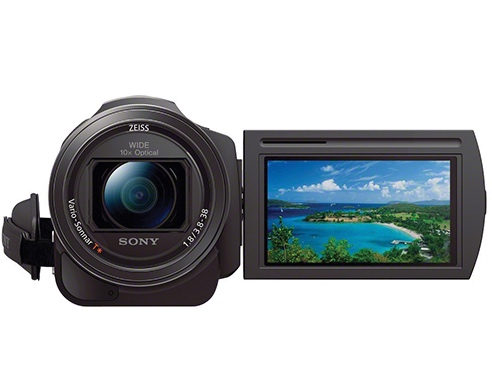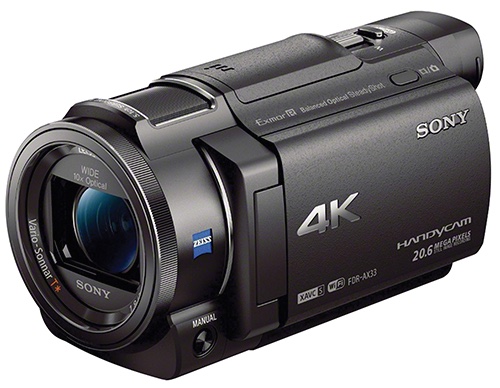 When I mentioned that I was reviewing a camcorder to some friends, the most common question asked was “… they still make those?” It’s a fair question; between high quality action cams and smartphones, it can be a bit difficult to see who would buy a camcorder in 2015. They’re not inexpensive, they’re not small, and they’re built for a pretty select task.
When I mentioned that I was reviewing a camcorder to some friends, the most common question asked was “… they still make those?” It’s a fair question; between high quality action cams and smartphones, it can be a bit difficult to see who would buy a camcorder in 2015. They’re not inexpensive, they’re not small, and they’re built for a pretty select task.
And that’s exactly why they’re still selling: if you want the best quality video, if you don’t want to miss a shot, if you want the power of a better, bigger lens with in-body stabilization, 5.1 microphone audio capture, and incredible zoom, you’re just not doing it with anything else. Yes there are smartphones out there that can shoot in 4k, or action cams that can shoot 120 frames per second, but putting all those features together with better battery life, better colour, and more manual control is something that takes a bigger, more dedicated device.
I’m not here to sell you on a camcorder, I’m just trying to point out that it’s easy to write camcorders off if you don’t really think about why they’re better. Getting my hands on the Sony FDR-AX33 reminded me of all of the things that I miss when I’m using my smartphone or my GoPro to shoot. Sure, they’re convenient, but it does feel like they’re a bit incomplete.
Please note: a sample video is coming soon. The Sony FDR-AX33 is an exceptional device, but for 4K it requires a very particular type of memory card—specifically one that can handle 50Mbps throughput. All of my current 4K cards top out at 45, and as such I was only able to record video in 1080p. Sony is sending out a new card to test with this camera and that video will go in this space when it arrives.
What’s inside?
Alright, back to the FDR-AX33. First: this thing is a Sony Handycam through and through. I’ve owned no less than four Handycams in the last 15 years; they’ve always duked it out with Canon for my love in the camcorder space. Sony has a few slick patents that make their cameras inherently better in my mind.
Super SteadyShot: this is Sony’s in-body stabilization for their cameras. It’s not hokum, they use both optical and digital stabilization techniques to smooth the heck out of the motion that your camcorder goes through. It makes even the most intolerable conditions watch-worthy; one of my favourites was shooting off the back of a motorbike a few years ago—even on a bumpy road the footage looked smooth.
InfoLithium: this is a technology that drives every other camera manufacturer in the business absolutely bonkers. It’s a patent on a method to display the exact time remaining in battery life for cameras. Ever wonder why Sony has time left in minutes but their competitors have a percentage or, worse yet, the three battery slices that tell you absolutely nothing about how long you’ve got left to shoot? Yeah. This is the reason.
Carl Zeiss Lens: the specially-coated Carl Zeiss Vario-Sonnar T* lens is built to produce better quality digital images with lower chromatic aberration–that means fewer weird colours in places where they shouldn’t be. Sony also has a habit of packing long zooms into their camcorder… which are still usable because the camera is stabilized with Super SteadyShot (and we’ve come full circle…)
Unboxing the Sony FDR-AX33
I pulled the FDR-AX33 out of the box and was surprised by how small it was; when Martin, the editor for Plug-In, asked me to write this blog he commented on how large the camera was. While it is weighty, I still find the FDR-AX33 rather tiny; perhaps I’m still remembering the good old days of shoulder-mounted camcorders, but anything that fits roughly in the palm of my hand gets dubbed as “tiny” in my mind.
The battery charges quickly, as all InfoLithium batteries do. This is a Sony FV70 series battery, with plenty of capacity. When I connected it to the camera it estimated over three hours of recording time available, and that wasn’t even on a full charge.
 Reviewing the camera’s performance
Reviewing the camera’s performance
Firing the camera up for the first time you’ll notice that it won’t be happy to start recording … until you pop a memory card in. Here’s a caveat: buy a good, fast memory card–actually, get two. Slower cards, even those listed as UHS-1, will sometimes not be fast enough for 4K recording. I had to do my first shoot in 1080p because the camera wasn’t pleased with the cards I had brought for use with it.
Controlling the camera is relatively easy; there’s your usual power toggle, recording button, and zoom rocker, but you can actually take full control of the camera using the bright, high resolution touch screen. There are plenty of things you can do from the camera itself, including streaming live over WiFi via Ustream and uploading clips to where you need them. I’ve never really found that helpful for my workflow, but it’s there if you need it. The camera also supports NFC so you can tap it against things to pair them, instead of taking the extra ten seconds to pair it manually.
I was particularly impressed with the zoom lens; I was able to zoom in up to 15x when shooting at 4k. It’s stable with SSS turned on, but I’d still recommend using a tripod instead if it comes down to using that feature on a regular basis. The 120fps slow motion recording is awesome, but still felt a bit like table stakes when you consider that phones and action cams do that too.
The real differentiator here is the lens. Crisp, clear edges. Bright, robust colours. Insane zoom. This is what you buy a camcorder for. You’ll capture detail here that your iPhone or Android phone will be able to do in about ten years.
A recap!
So, to recap:
- Colours – crisp and clear
- Video – stable and unbelievably sharp
- Battery life – unrivalled
- Storage – removable, but sold separately and needs to be high speed
- Size and Weight – definitely not in your pocket
- Other features – WiFi for streaming, NFC for connecting, will not send or receive calls or texts
Do you want the very best quality for your memories or for your art projects? Buy a Sony FDR-AX33. Not too concerned about the above? This might not be the device for you. Easy peasy.



